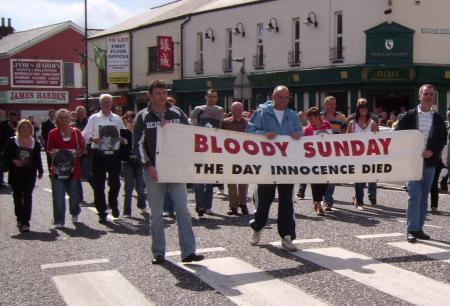Recounting the Troubles unsettling but necessary

January 1972 began with hopes of a new year and a new beginning in Northern Ireland. Newspapers and religious authorities were optimistic, as was a clairvoyant who we might consider amusing in his ineptitude were it not for the grim reality of the year that followed.
Because 1972 was, simply, one of the the worst years of the Troubles. Within the first hour of January eight bombs went off in Belfast. There would be a further 379 bombings in the same month alone, setting the tone for a vicious year of violence.
January concluded, of course, with Bloody Sunday. Civil rights demonstrators gathered in the Bishop Field District of the Creggan estate outside Derry. There was a carnival atmosphere. As the march made its way through the streets it encountered a number of barricades.
(Picture: Bloody Sunday March)
As Alan F. Parkinson writes in his new book 1972 and the Ulster Troubles, “What made this march so different was the one-sided employment of gunfire which would transform this single demonstration into a defining moment of the modern Northern Ireland conflict”.
Fourteen dead and 20 seriously injured. An act that served as a recruiter for previously non-violent citizens to the IRA, thereby propelling further violence.
Parkinson employs a wide range of primary sources in the book, including quotes from politicians, clergymen, and ordinary members of the public who remember the events of the year.
One civilian, Shane O’Doherty, remembers “If I could be shot dead for having taken part in a peaceful Civil Rights march, I might as well be shot for having fought the army murderers to the best of my ability... I knew that I would report back to the IRA... for operations within days. I now definitely viewed the British forces as terrorists in my country, murdering my people, and saw violence directed against them as a moral imperative”.
Of course this logic would lead to a cycle of violence, spiralling out of control and devastating the lives of many more families. Combine this with the powerful emotion of fear and clearly, in 1972, the peace process seemed an age away.
Speaking to Politico, Parkinson said “There were several emotions which prompted the violence - hatred, lust for power and revenge, as well as fear, getting one's 'retaliation' in first, so to speak”.
Mistakes made by the authorities are pointed out by him too. The move to direct rule from Westminster on March 24 pleased nobody. Few Protestants supported this and Republican attacks increased.
In the 24 hours between April 13 and 14, 23 bombs went off in Northern Ireland and the carnage continued when secret talks broke down between IRA leaders and British ministers.
The breakdown of these talks led to Bloody Friday, a series of bombings by the Provisional IRA on July 21. Nine dead and 130 injured. The spiral of violence continued.
So from the bombing of Abercomb restaurant on March 4 to the hunger strikes of May 15-June 19 the whole year in its bloody reality is painted starkly. Parkinson often portrays a scene of mundane ordinariness before reminding the reader that this is no ordinary story.
In many ways, then, the book is a highly unsettling read, but it is necessary nonetheless because, like all history, we can only move on to the future when we have a deep understanding of the past.
Minister for Justice Dermot Ahern recently said that the threat of dissident activity in the north "is as strong as it was at any time during the Troubles". Does Parkinson agree?
“I think the Justice Minister is right in drawing people's attention to the threat posed by dissident republicans who are growing more sophisticated and dangerous, though I do not feel they offer a viable political alternative at this stage to mainstream Sinn Fein”.
Speaking of Sinn Fein, I ask Parkinson if the revelations about Gerry Adams's personal life and the publication of Voices From The Grave, which essentially calls him a liar in relation to his involvement with the IRA, threaten his continuing role as leader of Sinn Fein?
“Adams has certainly had a lot of bad press recently, both in the way of revelations about his family and Ed Moloney's book. However, these allegations about Adams and his involvement in the IRA in 1972 and his alleged involvement in the 'disappeared' are nothing new, so I don't think they will, in themselves, have much impact upon his position”.
And what about Peter Robinson?
“Nothing will happen on his position until after the election. If the DUP lose seats to the UUP or Traditional Voice group, then there might well be a leadership challenge after the election”.
A chronological history of 1972 could become numbing and desensitising, but Parkinson skilfully engages the reader to imagine what it was like to have lived through the carnage of that year. As sectarian trouble rears its head once more in the north, we must never forget the cruel lessons of the past.

1972 and the Ulster Troubles by Alan F. Parkinson
Four Courts Press
Hardback, 400pp
€35
